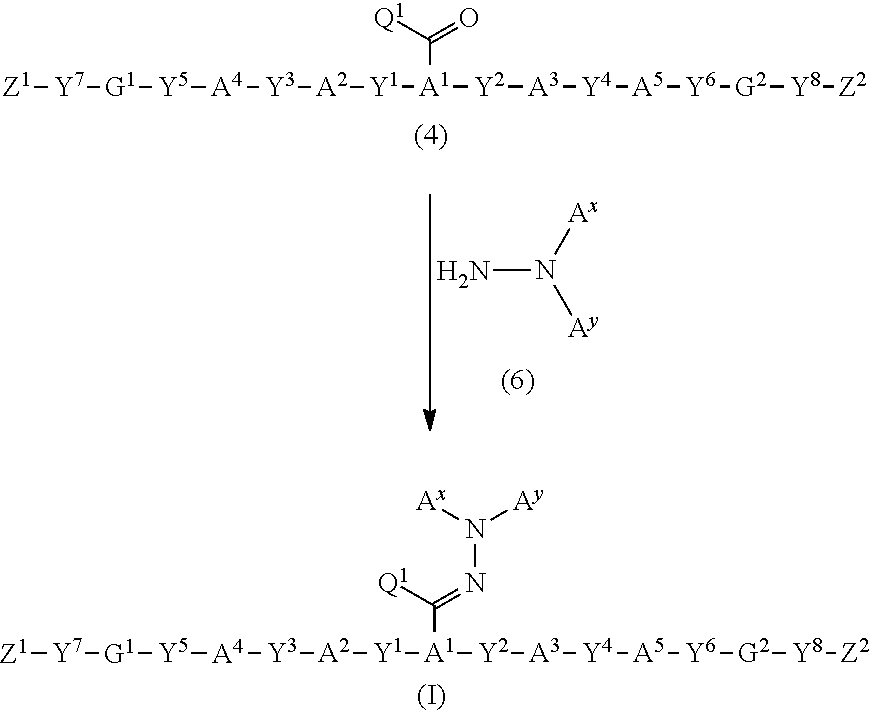Polymerizable compound, polymerizable composition, polymer, optically anisotropic body, and method for producing polymerizable compound
a technology of polymerizable compound and composition, applied in the direction of instruments, polarizing elements, organic chemistry, etc., can solve the problems of difficult application of low-molecular, inability to achieve accurate 1/4 or 12 retardation over the entire wavelength band, and inability to convert colored polarized light that passes through, etc., to achieve excellent solubility, low cost, and low melting point
- Summary
- Abstract
- Description
- Claims
- Application Information
AI Technical Summary
Benefits of technology
Problems solved by technology
Method used
Image
Examples
example 1
Synthesis of Compound 1
[0211]
Step 1: Synthesis of Intermediate A
[0212]
[0213]A three-necked reactor equipped with a thermometer was charged with 17.98 g (104.42 mmol) of trans-1,4-cyclohexanedicarboxylic acid and 180 ml of tetrahydrofuran (THF) under a nitrogen stream. After the addition of 6.58 g (57.43 mmol) of methanesulfonyl chloride to the mixture, the reactor was immersed in a water bath to adjust the temperature of the reaction mixture to 20° C. 6.34 g (62.65 mmol) of triethylamine was added dropwise to the reaction mixture over 10 minutes while maintaining the temperature of the reaction mixture at 20 to 30° C. After the dropwise addition, the mixture was stirred at 25° C. for 2 hours.
[0214]After the addition of 0.64 g (5.22 mmol) of 4-(dimethylamino)pyridine and 13.80 g (52.21 mmol) of 4-(6-acryloyloxyhex-1-yloxy)phenol (manufactured by DKSH) to the reaction mixture, the reactor was immersed in a water bath to adjust the temperature of the reaction mixture to 15° C. 6.34 g (...
example 2
Synthesis of Compound 2
[0224]
Step 1: Synthesis of Intermediate C
[0225]
[0226]A three-necked reactor equipped with a thermometer was charged with 9.00 g (70.01 mmol) of 3-amino-2-chloropyridine and 90 ml of concentrated hydrochloric acid under a nitrogen stream to prepare a homogeneous solution. After the addition of 10.21 g (105.01 mmol) of potassium thiocyanate to the solution, the mixture was stirred at 100° C. for 4 hours. After completion of the reaction, the reaction mixture was cooled to 20° C., followed by addition of 90 ml of water. The reaction mixture was added to 300 ml of a saturated sodium hydrogen carbonate aqueous solution while cooling the mixture with ice. The pH of the aqueous solution was adjusted to 8 by adding powdery sodium carbonate to precipitate crystals. The crystals were filtered off, washed with distilled water, and dried using a vacuum dryer to obtain 8.74 g of an intermediate C as a light yellow solid (yield: 83%).
[0227]The structure of the target produc...
example 3
Synthesis of Compound 3
[0240]
Step 1: Synthesis of Intermediate F
[0241]
[0242]A four-necked reactor equipped with a thermometer was charged with 20.0 g (125 mmol) of 1,4-dihydroxynaphthalene and 200 ml of N,N-dimethylformamide (DMF) under a nitrogen stream to prepare a homogeneous solution. After the addition of 51.8 g (375 mmol) of potassium carbonate and 19.4 ml (312 mmol) of methyl iodide to the solution, the mixture was stirred at 25° C. for 20 hours. After completion of the reaction, the reaction mixture was filtered through celite. The filtrate was added to 500 ml of water, and extracted with 500 ml of ethyl acetate. The ethyl acetate layer was dried over anhydrous sodium sulfate, and sodium sulfate was separated by filtration. Ethyl acetate was evaporated from the filtrate under reduced pressure using a rotary evaporator to obtain a white solid. The white solid was recrystallized from n-hexane (125 ml) to obtain 20.3 g of an intermediate F as colorless crystals (yield: 86.3%).
[...
PUM
| Property | Measurement | Unit |
|---|---|---|
| boiling point | aaaaa | aaaaa |
| reaction temperature | aaaaa | aaaaa |
| boiling point | aaaaa | aaaaa |
Abstract
Description
Claims
Application Information
 Login to View More
Login to View More - R&D
- Intellectual Property
- Life Sciences
- Materials
- Tech Scout
- Unparalleled Data Quality
- Higher Quality Content
- 60% Fewer Hallucinations
Browse by: Latest US Patents, China's latest patents, Technical Efficacy Thesaurus, Application Domain, Technology Topic, Popular Technical Reports.
© 2025 PatSnap. All rights reserved.Legal|Privacy policy|Modern Slavery Act Transparency Statement|Sitemap|About US| Contact US: help@patsnap.com



